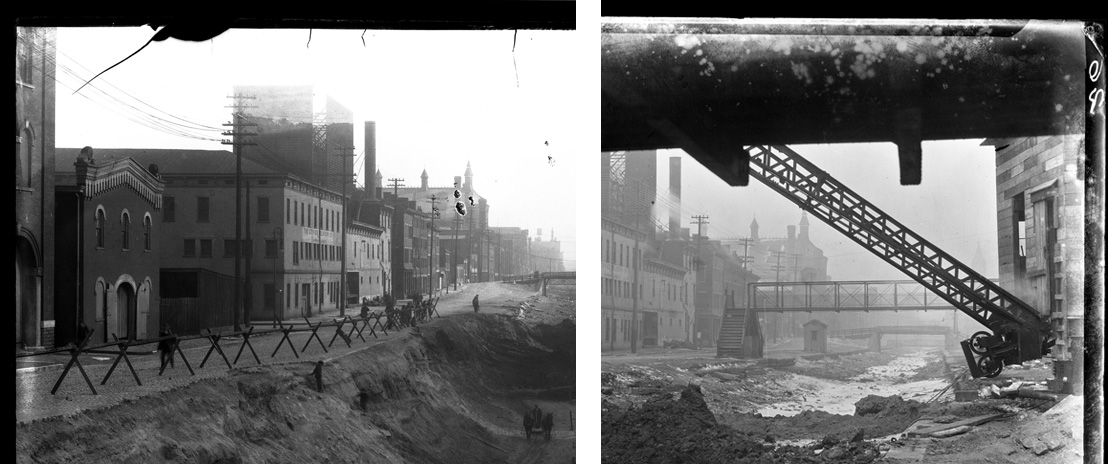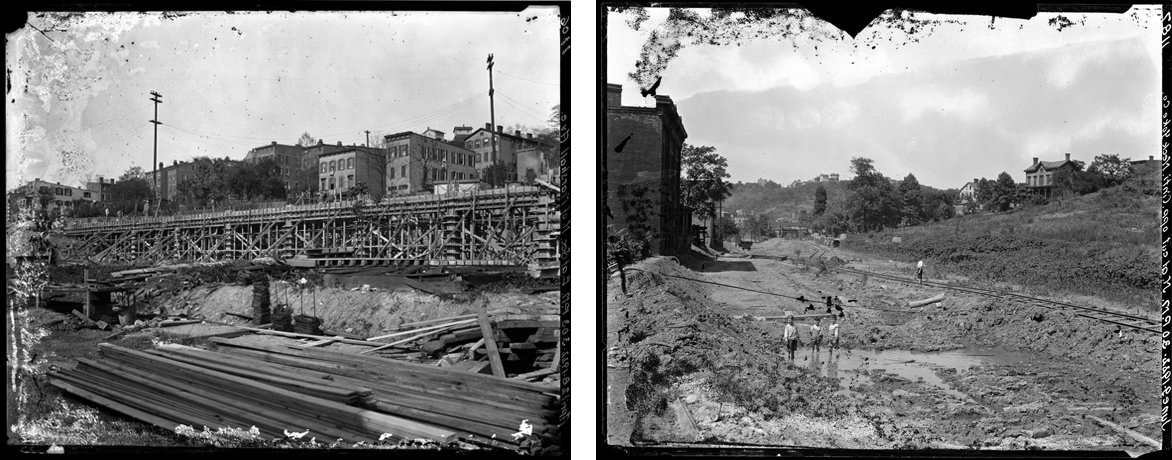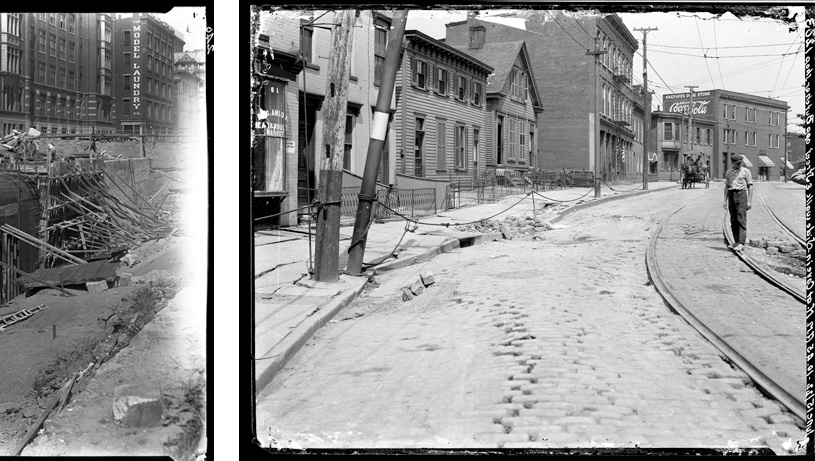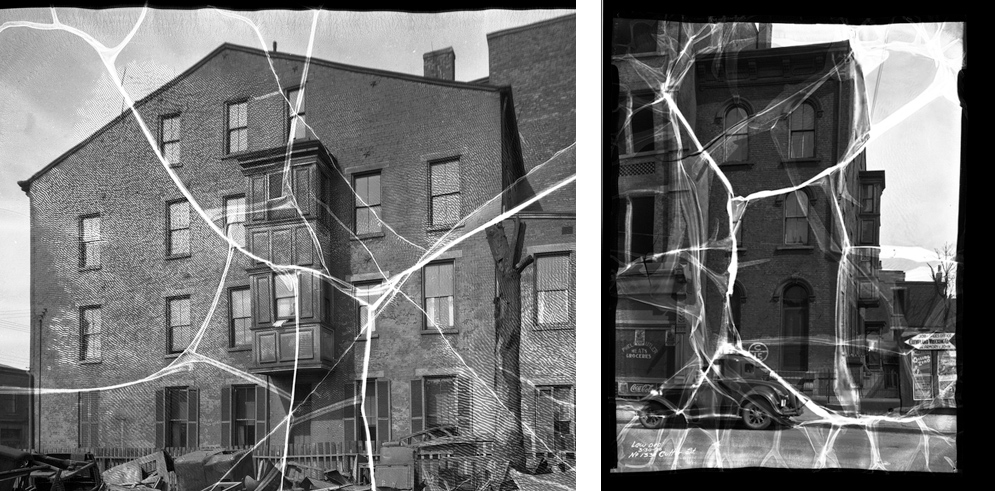By: Angela Vanderbilt
The University of Cincinnati’s Archives and Rare Books Library (ARB) maintains numerous collections containing records of historic value for research and scholarly use. These materials are comprised of a variety formats, including printed documents, university records, sound recordings, and photographic prints and negatives.
One of these collections is the Ohio Network collection, comprised of historic local government and public records. The City of Cincinnati Engineer Records is part of this collection, and contains records produced by the engineer’s office from 1851 through 1957, including those of the Rapid Transit Commission for the subway and Central Parkway construction, as well as other street improvements carried out by the city within the same timeframe. And among these records are the negatives and photographic prints that are currently being digitized and that will be made available online via the ARB and Digital Collections web sites.
An archival record, no matter its format, is inherently fragile due to a variety of factors which have been acting upon the physical record since its creation. Extreme fluctuations in temperature, humidity and light, as well as pests and improper handling of materials, are key factors to the deterioration of all archival records. Photographic negatives are no exception, whether they are metal, glass, paper or film – including nitrate, acetate, and polyester. In fact, they often are more susceptible to environmental factors than other records in a collection specifically because of their physical structure. And different types of negatives pose a greater risk to the overall health of a repository than others. Nitrate negatives, for instance, are inherently unstable due to the chemical structure of the cellulose nitrate support base to which the gelatin emulsion and silver halide image are adhered, and are prone to combustion if not properly ventilated and stored at temperatures at or below 68° Fahrenheit and relative humidity between 20-30%.
Because of its unstable nature, cellulose nitrate film is considered a hazardous material by the EPA and the National Fire Protection Association. Information regarding nitrate negatives storage and handling is available on the NFPA website, the National Archives website, the Kodak website, as well as through the National Parks website and the Northeast Document Conservation Center. Due to this classification, it is considered best practice within the archival community to remove and dispose of this type of negative in order to ensure the overall health and safety of the entire repository, as well as staff and visitors. It is extremely important, then, to know what types of negatives are contained within a collection to ensure the overall health of the repository.
Nitrate negatives were commonly used between 1889 and 1951 for both still prints and motion picture film. Collections containing negatives or film from this time period will most likely include cellulose nitrate negatives. There are several ways to identify nitrate negatives: edge printing and notches, date information, deterioration characteristics, and testing. The last method is a series of tests performed on the film itself, three of which require a sample portion of negative material to be used, and thus are destructive to the negative. Because of this, these tests should not be performed until other procedures have been attempted but identification is still undetermined. These tests are described in the preservation leaflet “A Short Guide to Film Base Photographic Materials: Identification, Care, and Duplication”, found on the Northeast Document Conservation Center’s website.
For the subway and street improvement negatives, because there are also a number of cellulose acetate negatives in the collection, the first three methods were used to identify the nitrate negatives so they could be separated from the rest of the collection after scanning. The method most commonly used was edge printing and notches. Along the edge of the negative the manufacturer often stamped their name along with the type of negative, for instance “EASTMAN — NITRATE — KODAK” or “EASTMAN — SAFETY — KODAK”. Not all manufacturers stamped the film, but most included the notch codes, using a series of V-shaped cuts to identify nitrate and a combination of U- and V-shaped cuts for acetate, or Safety Film.
However, in cases where there was no edge printing or the notched portion of the film was broken off, negative type was determined using date and deterioration methods. Since the manufacture date of nitrate and acetate overlapped between the 1930s-1950s, and no date information was provided on some negatives, deterioration methods proved to be more useful, especially since they are relatively distinct between the two types of film. Nitrate negative deterioration occurs in several stages, beginning with a discoloration as the film turns a yellowish or amber color. Mold and mildew may begin to grow on the emulsion side of the negative, or it may become sticky as nitric acid is released. The silver halide in the image begins to separate and mirroring, or ‘silvering out’, begins. In some cases of advanced deterioration, the negatives may be stuck together. The film becomes very brittle, and eventually the emulsion turns into a powder as it is released from the support base and is highly acidic. Acetate negatives deteriorate in a similar progression. The support layer begins to curl and shrink as it deteriorates causing the emulsion layer to separate from the acetate support layer. This creates a bubbled or channeled surface, and the support becomes very brittle. Acetate negatives also produce an acidic odor, but is more similar to the smell of vinegar when deteriorating, which is referred to as “Vinegar Syndrome.”

Nitrate negatives at stages 1, 2 & 3 – image fading/silvering out of emulsion, mold/mildew on emulsion

Nitrate negatives at stage 3 – build-up of nitric acid caused emulsion to adhere to adjacent negative
In either case, whether nitrate or acetate deterioration, the gases produced by the negatives are harmful to other materials contained within collections stored in close proximity to the negatives, and measures must be taken to safeguard those other records. Separating the negatives from other records is vital, as is maintaining consistent temperature, RH and light levels, as well as good ventilation. Disposal of the nitrate negatives according to EPA guidelines for hazardous materials is necessary to ensure the safety of the repository, staff, and patrons, as stated earlier.
As mentioned, the danger of cellulose nitrate negatives is combustion. If you’ve ever seen a movie in which a filmstrip bubbles up and melts, that would be nitrate film. At high temperatures, nitrate will catch fire, whether it is exposed directly to a heat source or tucked away in a canister on a shelf – if proper ventilation, temperature, and humidity levels are not maintained. Photographic negatives are comprised of three layers = a support layer (metal, glass, paper or plastic) to which a binder is applied (albumen, collodion or gelatin) within which is suspended the image material (silver halide, platinum, pigments). In the case of cellulose nitrate negatives, it is the plastic support that is the unstable element – which is made of cellulose nitrate. As nitrate ages, it generates nitrogen oxide and nitric acid. If contained within a sealed canister, these gases have no means of dissipating. As more nitrogen oxide is produced, it becomes combustible and once ignited, is nearly impossible to extinguish since it is generating its own fuel source as it burns – more nitrogen oxide.
The gelatin and silver halide applied to the plastic support are not hazardous, but are susceptible to the effects of the nitrate’s deterioration. The emulsion and silver image break down over time as the nitrate deteriorates and oxidizes, resulting in a loss of the image and historic information it provides. “Silvering out” is one result. In this process, the gelatin binder is weakened and the silver particle is released, moving to the surface of the binder where it produces a metallic, reflective surface. When viewed at an angle, it generates a positive instead of negative image. In other cases, the image becomes cloudy, or the negative becomes discolored, usually turning an amber color due to chemical breakdown. Each is part of a 6-stage progression of deterioration which is unstoppable once it begins, but can be slowed through environmental controls such as cold storage.
In order to capture the image before it is completely lost, it is recommended that such negatives be reproduced through digitization. For the subway and street improvement negatives and prints, a high resolution scan was generated for each negative (as well as for acetate negatives and prints) using a cold lamp scanner to ensure the records were not exposed to a heat source. All negatives were scanned at 600 dpi 8-bit grayscale and saved in TIF format. Prints were also scanned at 600 dpi 8-bit grayscale and saved in TIF format (back of prints at 300 dpi).
The negatives and prints were returned to ARB along with portable hard drives containing the TIF images, which were downloaded and backed up in multiple locations for safekeeping. Image files were reviewed for accuracy and quality as the online repository has been built, and the boxes containing the nitrate negatives, as well as badly deteriorated acetate negatives, were transferred to the Preservation Lab at UC’s Langsam Library for cold storage until completion of the digitization project. Once the online repository is complete and made publicly accessible, arrangements will be made by the Preservation Lab in conjunction with UC Environmental Health & Safety for the safe disposal of the nitrate negatives.
Sources:
http://motion.kodak.com/motion/Support/Technical_Information/Storage/storage_nitrate.htm
http://www.nps.gov/museum/publications/handbook.html
http://www.connectingtocollections.org/archivephotograph/
http://www.conservation-us.org/index.cfm?fuseaction=Page.viewPage&pageId=633&parentID=497
http://thepreservationlab.org/
http://www.hse.gov.uk/pubns/indg469.htm
 This project is funded by a grant for $60,669 through the Library Services and Technology Act, administered by the State Library of Ohio.
This project is funded by a grant for $60,669 through the Library Services and Technology Act, administered by the State Library of Ohio.





